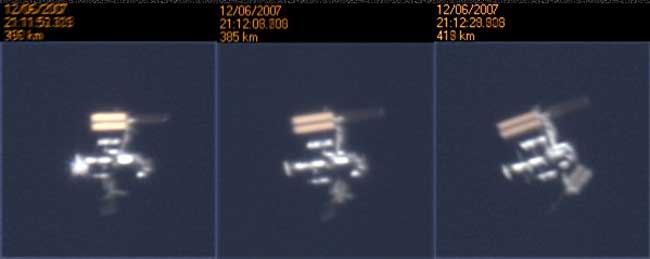
Sporting a new pair of solar arrays and functioning as ports for four docked spacecraft, the International Space Station (ISS) is the brightest it’s ever been--so bright that ground astronomers are seeing “ISS flares” from sunlight bouncing off all its shiny surfaces.
The station is far brighter than any star in our sky and occasionally flares to brilliance in the night sky.
As it is configured now, the ISS has an apparent brightness, or “magnitude,” of around -3 (lower numbers denote brighter objects on this scale), said Joe Rao, SPACE.com’s nightsky columnist.
“Of course, a ‘flare’ would briefly make it appear much brighter,” Rao said.
The space station is currently four times brighter than Sirius, the brightest star in the night sky; its luminance rivals Jupiter but is less than that of Venus, which has an apparent magnitude of around -4.
Currently attached to the ISS are two unmanned resupply spacecraft—Progress 24 and 25—a Russian Soyuz TMA-10 spacecraft that ferried the two Expedition 15 cosmonauts currently aboard the station, and NASA’s space shuttle Atlantis, which docked with the orbital laboratory on Sunday. Spacewalkers also recently unfurled a new pair of power-generating solar arrays on the station that were delivered courtesy of Atlantis.
Using a 10-inch Meade LX-200 telescope, amateur astronomer Mike Tyrell glimpsed a flare from the space station’s solar arrays as it passed over England Tuesday evening. “The ISS is by far the most interesting object to track,” said Tyrell, who has developed his own software to track satellites.
Get the Space.com Newsletter
Breaking space news, the latest updates on rocket launches, skywatching events and more!
“The flare from the Progress panels was a real bonus,” Tyrell told SPACE.com.
Rao notes that the “flaring” phenomenon has been observed with other spacecraft in the past.
“Satellite observers are very well acquainted with this phenomenon,” Rao said. “I also remember seeing occasional flares likely emanating off of the windmill-shaped solar array of the now-defunct Skylab Space Station during the late 1970s."
The ISS flares were first reported on SpaceWeather.com. The space station's location can be tracked on this NASA site.
- The Strangest Things in Space
- Our Tiny Universe: What's Really Visible at Night
- Video: Shiny Space Station Flares for Cameras
- Complete Shuttle Mission Coverage
Join our Space Forums to keep talking space on the latest missions, night sky and more! And if you have a news tip, correction or comment, let us know at: community@space.com.
Ker Than is a science writer and children's book author who joined Space.com as a Staff Writer from 2005 to 2007. Ker covered astronomy and human spaceflight while at Space.com, including space shuttle launches, and has authored three science books for kids about earthquakes, stars and black holes. Ker's work has also appeared in National Geographic, Nature News, New Scientist and Sky & Telescope, among others. He earned a bachelor's degree in biology from UC Irvine and a master's degree in science journalism from New York University. Ker is currently the Director of Science Communications at Stanford University.









